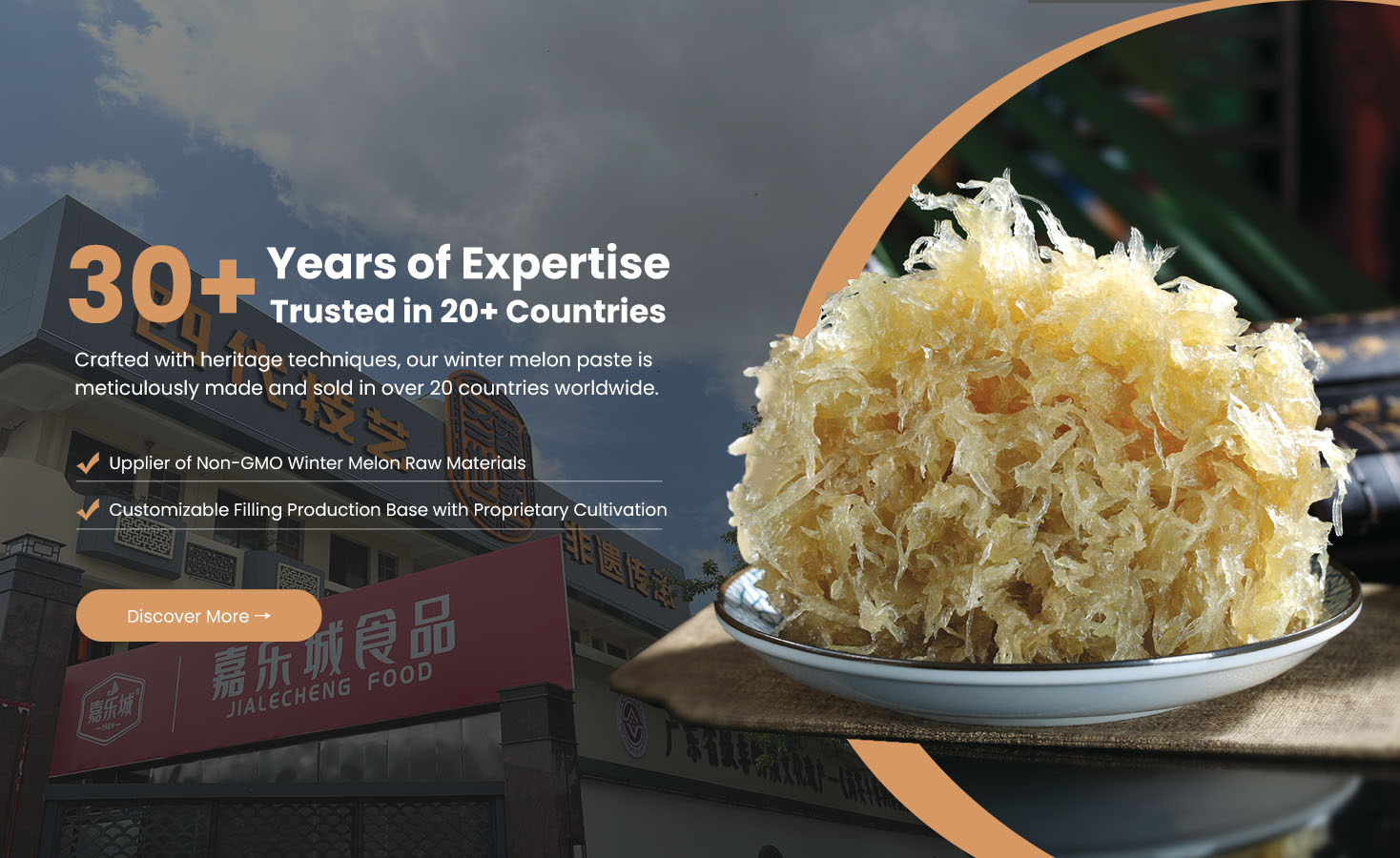What Makes Winter Melon Filling Different From Lotus Seed Or Red Bean Paste?
In the world of traditional Chinese pastry fillings — especially for mooncakes, wife cakes, and other baked desserts — the three most common bases are winter melon, lotus seed, and red bean. While they share similar preparation methods, each offers unique texture, flavor, cost, and processing characteristics.
Among them, Winter Melon Filling stands out as the most versatile and cost-efficient base, widely used by modern manufacturers such as Jialecheng Foods for large-scale pastry production.
Let’s compare them in detail to understand what makes Winter Melon Filling different — and why it’s so widely adopted in today’s food industry.
1. Ingredient Source and Composition
| Filling Type | Main Ingredient | Natural Composition | Key Property |
|---|---|---|---|
| Winter Melon Paste | Fresh winter melon (white gourd) | 90% water, low starch | Mild flavor, translucent texture |
| Lotus Seed Paste | Dried lotus seeds | High starch, protein, oil | Rich, creamy taste |
| Red Bean Paste | Adzuki beans | High fiber, starch, tannins | Dense, earthy sweetness |
Winter melon is a high-moisture, low-starch fruit, while lotus and red bean are dry legumes/seeds that require rehydration and prolonged boiling. This difference determines how each paste behaves in terms of texture, sweetness, and processing time.
2. Flavor Profile and Aroma
| Filling Type | Flavor Description | Sweetness Level | Aroma |
|---|---|---|---|
| Winter Melon | Mild, clean, slightly honeyed | Medium | Neutral, easily flavored |
| Lotus Seed | Naturally sweet, nutty | High | Distinct floral-nut aroma |
| Red Bean | Earthy, robust, slightly bitter | Medium-high | Strong, beany fragrance |
Winter melon’s neutral flavor allows it to act as a base material for blending with other flavors such as coconut, pineapple, sesame, or matcha.
In contrast, lotus seed and red bean have distinctive natural flavors that limit their flexibility but give traditional pastries their signature taste.
3. Texture and Appearance
| Filling Type | Texture | Appearance | Behavior in Baking |
|---|---|---|---|
| Winter Melon | Smooth, chewy, slightly elastic | Glossy, translucent amber | Retains moisture and shape |
| Lotus Seed | Fine, creamy, dense | Pale yellow to golden | Can dry out easily if overbaked |
| Red Bean | Thick, fibrous, slightly grainy | Deep reddish-brown | Can split or crack when overcooked |
Winter melon paste is softer and glossier, offering a flexible, cohesive texture that holds up well under heat.
Lotus seed paste, on the other hand, is dense and rich, while red bean paste tends to be grainier because of its fibrous hull.
4. Processing and Production Efficiency
| Step | Winter Melon | Lotus Seed | Red Bean |
|---|---|---|---|
| Raw material preparation | Easy – peel and cube | Requires long soaking | Requires soaking and dehusking |
| Cooking time | Short (45–60 min) | Long (2–3 hrs) | Moderate (1.5–2 hrs) |
| Grinding/refining | Simple blending | Fine grinding for smoothness | Requires dehulling and sieving |
| Vacuum concentration | Efficient (high yield) | Slower, lower yield | Moderate efficiency |
| Shelf life | Long (6–12 months) | Medium (4–6 months) | Medium (4–6 months) |
Industrial producers prefer winter melon because it’s easier to process, yields more paste per kilogram, and maintains consistency under mechanical production.
5. Cost Efficiency
| Filling Type | Raw Material Cost | Production Yield | Typical Industrial Use |
|---|---|---|---|
| Winter Melon Paste | Low | High (≈80–85%) | Mass production, blended fillings |
| Lotus Seed Paste | Very high | Moderate (≈60–65%) | Premium mooncakes |
| Red Bean Paste | Moderate | Moderate (≈65–70%) | Traditional pastries, buns |
Winter melon paste is the most economical option because the raw fruit is inexpensive and available year-round.
That’s why large manufacturers often blend winter melon paste with lotus or red bean paste to reduce cost while maintaining texture and flavor.
6. Customization Potential
| Feature | Winter Melon | Lotus Seed | Red Bean |
|---|---|---|---|
| Flavor adaptability | Excellent | Moderate | Low |
| Color adjustment | Easy (via caramel or fruit syrup) | Limited | Difficult |
| Texture modification | Very flexible (by moisture/sugar control) | Moderate | Harder to adjust |
| Modern flavors | Pairs well with fruits, nuts, matcha | Mostly used in classic pastries | Limited to traditional recipes |
Winter melon serves as a universal base — it can mimic or complement the texture of other fillings. For instance, manufacturers can mix it with lotus seed paste to achieve a similar mouthfeel at a lower cost, or infuse it with fruit pulp for contemporary bakery lines.
7. Baking Performance and Stability
| Property | Winter Melon | Lotus Seed | Red Bean |
|---|---|---|---|
| Heat stability | Excellent | Good | Moderate |
| Oil separation | Low | Moderate | Low |
| Moisture retention | Excellent | Fair | Good |
| Cracking after baking | Rare | Common if overbaked | Occasional |
| Shelf life | Long (6–12 months) | Medium (4–6 months) | Medium (4–6 months) |
Because of its natural fiber and high water-binding capacity, winter melon paste resists drying and cracking — a major advantage for mooncakes that undergo multiple heating stages.
8. Color and Presentation
| Filling | Color After Cooking | Appearance in Pastry |
|---|---|---|
| Winter Melon | Light amber to golden | Shiny, translucent center |
| Lotus Seed | Pale golden | Smooth, dense interior |
| Red Bean | Deep reddish-brown | Matte, solid texture |
Winter melon paste adds a luminous sheen that enhances the visual appeal of baked pastries. Lotus and red bean fillings, though flavorful, tend to appear opaque and matte.
9. Shelf Life and Storage
Winter melon paste, due to its sugar concentration (30–35%) and low final moisture (18–22%), has a naturally longer shelf life. Vacuum-sealed, it can last up to 12 months without texture loss.
Lotus seed and red bean pastes have higher fat or protein content, which can oxidize or ferment faster, limiting their storage stability.
| Paste | Shelf Life | Main Spoilage Cause |
|---|---|---|
| Winter Melon | 6–12 months | Sugar recrystallization (rare) |
| Lotus Seed | 4–6 months | Oil rancidity |
| Red Bean | 4–6 months | Fermentation, mold |
10. Summary Comparison
| Feature | Winter Melon Paste | Lotus Seed Paste | Red Bean Paste |
|---|---|---|---|
| Flavor | Mild, neutral | Sweet, nutty | Earthy, rich |
| Texture | Smooth, elastic | Creamy, dense | Thick, grainy |
| Color | Translucent golden | Pale yellow | Deep brown |
| Cost | Low | High | Medium |
| Processing | Simple, fast | Labor-intensive | Moderate |
| Baking Stability | Excellent | Fair | Good |
| Customization | Highly versatile | Limited | Low |
| Shelf Life | 6–12 months | 4–6 months | 4–6 months |
11. Why Manufacturers Like Jialecheng Prefer Winter Melon
Stable supply through controlled local cultivation.
Consistent quality with moisture and viscosity control via vacuum concentration.
Flexible product development — serves as a base for fruit-, nut-, or tea-flavored fillings.
Economical for large-scale production, reducing overall ingredient cost for OEM and ODM bakery clients.
12. Conclusion
What sets winter melon filling apart from lotus seed or red bean paste is its neutral flavor, glossy texture, processing efficiency, and cost-effectiveness.
It acts as the universal foundation of Asian pastry fillings — easily flavored, heat-stable, and long-lasting — making it ideal for both traditional mooncakes and modern bakery innovations.
Through precision control of moisture, viscosity, and sugar balance, manufacturers like Jialecheng Foods have perfected this humble ingredient into a reliable, high-performance filling that defines the modern pastry industry.




